

Most ebook files are in PDF format, so you can easily read them using various software such as Foxit Reader or directly on the Google Chrome browser.
Some ebook files are released by publishers in other formats such as .awz, .mobi, .epub, .fb2, etc. You may need to install specific software to read these formats on mobile/PC, such as Calibre.
Please read the tutorial at this link: https://ebookbell.com/faq
We offer FREE conversion to the popular formats you request; however, this may take some time. Therefore, right after payment, please email us, and we will try to provide the service as quickly as possible.
For some exceptional file formats or broken links (if any), please refrain from opening any disputes. Instead, email us first, and we will try to assist within a maximum of 6 hours.
EbookBell Team

5.0
50 reviewsMaster advanced techniques and algorithms for machine learning with PyTorch using real-world examples
Key Features
Understand how to use PyTorch to build advanced neural network models including graph neural networks and reinforcement learning models
Learn the latest tech, such as generating images from text using diffusion models
Become an expert in deploying PyTorch models in the cloud, on mobile and across platforms
Get the best from PyTorch by working with key libraries, including Hugging Face, fast.ai, and PyTorch Lightning
Book Description
PyTorch is making it easier than ever before for anyone to build deep learning applications. This PyTorch book will help you uncover expert techniques to get the most from your data and build complex neural network models.
You'll create convolutional neural networks (CNNs) for image classification and recurrent neural networks (RNNs) and transformers for sentiment analysis. As you advance, you'll apply deep learning across different domains, such as music, text, and image generation using generative models. You'll not only build and train your own deep reinforcement learning models in PyTorch but also deploy PyTorch models to production, including mobiles and embedded devices. Finally, you'll discover the PyTorch ecosystem and its rich set of libraries. These libraries will add another set of tools to your deep learning toolbelt, teaching you how to use fast.ai for prototyping models to training models using PyTorch Lightning. You'll discover libraries for AutoML and explainable AI, create recommendation systems using TorchRec, and build language and vision transformers with Hugging Face.
By the end of this PyTorch book, you'll be able to perform complex deep learning tasks using PyTorch to build smart artificial intelligence models.
What you will learn
Implement text, image, and music generating models using PyTorch
Build a deep Q-network (DQN) model in PyTorch
Deploy PyTorch models on mobiles and embedded devices
Become well-versed